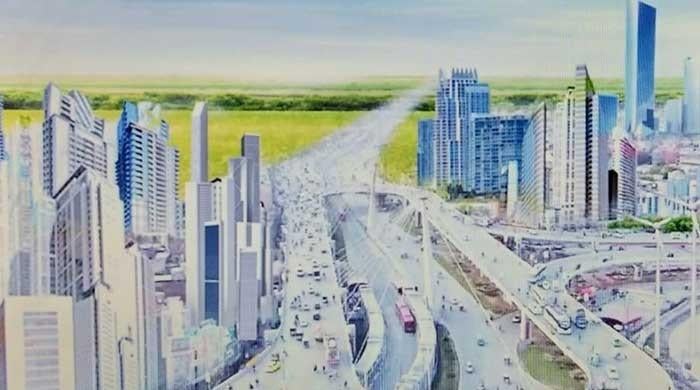Earthquakes and the dream of vertical cities in Pakistan

On December 20, an earthquake measuring 6.4 on the Richter Scale jolted Islamabad, Lahore, Peshawar and other surrounding cities, killing a child and injuring a dozen or so people.
The tremors were felt at 4:39 pm, a time when schools are shut. But those who were in their offices, in high-rise buildings, rushed outside as panic ensued.
After the earthquake several cracks were visible at Peshawar’s Bacha Khan International Airport, raising questions about the sturdiness and safety of such mega projects.
Tremors are a normal occurrence in many parts of the world. To overcome this natural phenomenon, buildings, including skyscrapers, are constructed in a manner that allow them to withstand shocks measuring up to 7.0 on the Richter Scale. Despite Pakistan being situated on major geographical fault lines, it has yet to adopt this approach.
State regulating authorities in the country charge a high fee for approving a building’s design and ensuring that regulations and codes are followed till completion. But instead of ensuring that these structures are earthquake resistant, the authorities only spur to action after the calamity has struck, to distribute cheques amongst the affected.
In the last four months, Pakistan has been jolted by four earthquakes. In October, Khyber Pakhtunkhwa was struck twice. While in September, a 5.6 magnitude earthquake left over 30 people dead and 300 injured.
The need to implement building codes has become even more urgent after the prime minister recently announced his vision for future cities. Prime Minister Imran Khan believes that Pakistani cities have been expanding horizontally for a long time now and it is now time for vertical cities.
No doubt, the skylines of Dubai, Hong Kong, Shanghai, Sydney, Vancouver, New York and many other places attract tourists. Our country will be equally proud to have iconic skylines off the coast of Karachi, or in the historic city of Lahore or in the midst of the picturesque Islamabad.
But, without fully observing international safety standards, vertical buildings can be a disaster in the making. One reason is that these giant steel and glass structures add to global warming.
In the last two decades, at least three dozen buildings have been constructed in Pakistan which stand over hundred meters tall. The tallest has touched the three hundred metres’ mark and many more similar projects are in the pipeline.
Are we ensuring that these skyscrapers will withstand a major earthquakes?
Regrettably, our history is replete with horrendous examples of houses built without a No Objection Certificate (NOC) or of owners and renters allowed to move into an apartment building before a completion certificate is issued.
Tragic memories of Margalla Tower in F-10 Islamabad are still afresh. The inhabitants had moved in the structure without receiving a completion certificate, never imagining that seventy-eight of them would die in the 2005 earthquake. In the aftermath of which, officials of the Capital Development Authority were held responsible for ignoring an unsteady and unsafe structure in the capital.
The then Relief Commissioner Lt-Gen (retd) Farooq Ahmed admitted that some “influential people” were forcing him to mold the facts of the probe into a tragedy.
Instead of learning lessons from the destruction of the towers, our authorities chose to bury their heads in sand. One wonder's if we are waiting for anther tragedy to strike.
One of the country’s top architect and planner, Zia Askari, who built the iconic Parliament House in Islamabad and the building of the new Sindh Assembly insists that implementing the state rules are essential to ensure that buildings can endure earthquakes.
When the 2005 seismic activity shook Pakistan, Askari was confident that the Parliament House would remain undamaged. He was right.
Elsewhere, the 7.6 magnitude tremor resulted in the deaths of over 80,000 people and left three million homeless. Entire towns in Azad Kashmir and Khyber Pakhtunkhwa were destroyed, leaving Sardar Sikandar Hayat Khan to mourn that “I am a Prime Minister of a graveyard”.
Pakistan will need to adopt modern and urban development strategies to tackle the issue. For which it must look East.
Japan has dramatically improved its infrastructure in the past few years by applying precise engineering and using strong construction material. Their Akashi Kaikyo bridge is a masterpiece of construction. In the last twenty years, the bridge, which is the world’s longest suspension structure, has not gone through any repairs since its opening. It connects the earthquake-prone-Kobe with two Islands on the other side of the sea. Yet, since completion, it has been repainted only once. Japan is also home to the Tokyo Skytree tower.
Japan is now constructing buildings which can absorb up to 8 magnitude shocks. To further ensure that its citizens remain safe during earthquakes, Japanese are encouraged to visit earthquake-simulation centres. Visitors to these places are then educated on how to take shelter inside their apartments and what sort of furniture and appliances they should opt for.
Overpowering violent ground motions doesn’t come cheap. But it is a cost that we must pay to save lives.


Post a Comment